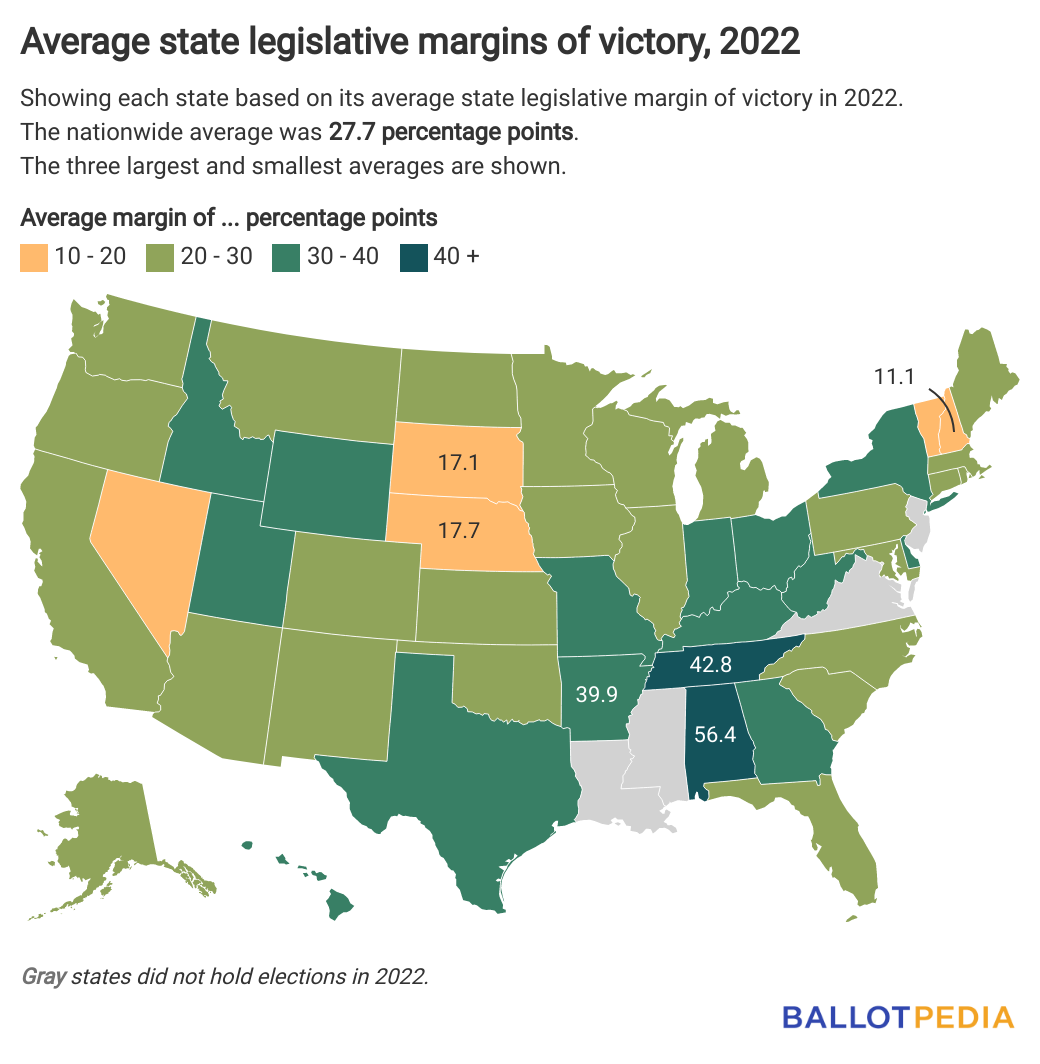Welcome to the Friday, February 10, Brew.
Here’s what’s in store for you as you start your day:
- Average margin of victory in state legislative races continued upward trend in 2022
- Five statewide ballot measure certified for 2023, 10 for 2024
- #FridayTrivia: How many state legislative chambers had guaranteed majorities in 2022?
Have a minute and an opinion? Take our 2023 reader survey!
Average margin of victory in state legislative races continued upward trend in 2022
The average margin of victory in last year’s state legislative elections was 27.7 percentage points. This is the highest even-year average of the last three election cycles, up from 27.0 percentage points in 2020 and 25.8 in 2018.
We define the margin of victory as the difference between a winning candidate’s vote share and that of the runner-up. For example, if Candidate A wins with 55% of the vote and Candidate B finishes with 45%, the margin of victory is 10 percentage points.
Legislators in Alabama won by an average margin of 56.4 percentage points, the most in the country. Tennessee and Arkansas followed, with average margins of 42.8 and 39.9 percentage points, respectively.
New Hampshire had the closest races, with legislators winning by an average margin of 11.1 percentage points, followed by South Dakota and Nebraska with average margins of 17.1 and 17.7 percentage points, respectively.
Democrats gained control of four chambers in 2022: the Michigan House and Senate, Minnesota Senate, and Pennsylvania House. The average margins of victory in these chambers was below the national average:
- Michigan House: 26.9 percentage points
- Michigan Senate: 25.2 percentage points
- Minnesota Senate: 26.7 percentage points
- Pennsylvania House: 27.6 percentage points
As average margins of victory trend upward, the percentage of seats won by narrow margins has gradually decreased, due in part to an increase in the number of candidates running unopposed.
The percentage of races decided by 10 percentage points or fewer decreased from 19% in 2018 (505 Dems., 573 Reps.) to 15% in 2022 (471 Dems., 404 Reps.).
Meanwhile, the number of races decided by more than 10 percentage points decreased slightly from 53% in 2018 (1,238 Dems., 1,765 Reps.) to 52% in 2022 (1,460 Dems., 1,582 Reps.).
The number of candidates running without major party opposition increased from 28% in 2018 to 30% in 2022. Unopposed Republicans drove this growth, increasing 101% from 591 in 2018 to 1,186 in 2022. The number of unopposed Democrats decreased 24% from 974 in 2018 to 745 in 2022.
The only tied race during the past three cycles occurred in 2022. In New Hampshire House of Representatives District Staford 8, Rep. Chuck Grassie (D) and David Walker (R) received 970 votes each. Both candidates are running in a redo election on Feb. 21 to determine the winner.
Five statewide ballot measures certified for 2023, 10 for 2024
As of Feb. 9, five statewide measures have been certified for the ballot in three states for 2023. That’s equal to the average number of measures certified at this point in an odd-year cycle based on data since 2011.
Those five measures, and their election dates, are shown below:
- March 7: Oklahoma State Question 820, Marijuana Legalization Initiative
- April 4: Wisconsin Question 1, Conditions of Release Before Conviction Amendment
- April 4: Wisconsin Question 2, Conditions for Cash Bail Amendment
- April 4: Wisconsin Work Requirement for Welfare Benefits Advisory Question
- Nov. 18: Louisiana Gubernatorial Deadlines on Bills and Legislative Veto Sessions Amendment
We also know that 10 statewide measures have already been certified for the ballot in four states for 2024. That’s four more than the average number certified at this point in an even-year cycle based on data since 2012.
Here are some recent updates:
- Two new measures were certified for the ballot last week, both in California:
- Sponsors submitted signatures, pending verification, for two initiatives in Maine and Michigan:
- Officials verified four indirect initiatives in Maine and Ohio, which will now go to legislators for further action:
From 2011 to 2021, the average number of statewide ballot measures certified in an odd-numbered year was 33. By this point, in odd-numbered years from 2011 through 2021, an average of five statewide measures had been certified for the ballot.
Keep reading
#FridayTrivia: How many state legislative chambers had guaranteed majorities in 2022?
We brought you post-filing deadline information from Mississippi in the Thursday Brew. Based on state legislative candidate filings, the number of Republicans running without Democratic opponents is large enough to guarantee Republican majorities in both chambers before any ballots are cast this November.
How many state legislative chambers had guaranteed majorities in 2022?


